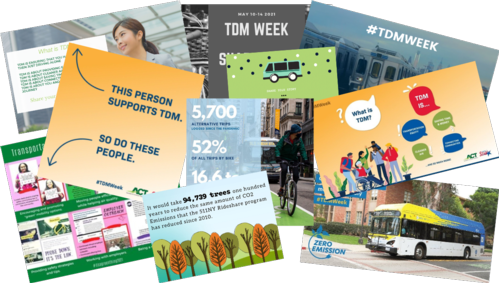ACT celebrated the inaugural
TDM Week, May 10-14th, where transportation demand management (TDM) professionals took to social media to spread awareness of TDM policies & strategies. Organizations shared their program success stories, educated their followers on the
benefits of TDM, and shared examples of how TDM could be better supported through policy.
TDM strategies are used to seeks to enhance existing transportation infrastructure to create more efficient, accessible, and effective mobility systems that moves all people. With over 320 posts about #TDMWeek across LinkedIn, Twitter, Instagram, and Facebook, and a reach of over 430,000, ACT members shared the wide variety of TDM strategies, from behavior marketing to increasing transit ridership, to introducing telework policies.
This year, Congress has the opportunity to pass the
Mobility Options, Resiliency, and Efficiency (MORE) Through TDM Act (HR 2514), which would codify TDM and TDM strategies withing federal code, provide $1.25 billion in new funding to support new TDM plans, and require all states to include TDM into their long-range transportation plans. The MORE Through TDM Act would be a significant step in supporting TDM as a key federal transportation policy strategy and ACT strongly supports its passage.
Increasing levels of congestion has become a universal problem. Time spent sitting behind the wheel stuck in traffic is time wasted, not to mention the harm personal vehicles can cause to the worsening climate crisis. The transportation sector contributes the largest proportion of greenhouse gas emissions and, within that, personal vehicles were the largest source of transportation emissions, according to the Environmental Protection Agency (EPA). TDM initiatives seek to create a cleaner, more sustainable, and resilient transportation system that would reduce traffic and emissions, all while getting people to where they need to go.
To achieve our goals of reduced congestion, cleaner air, and more sustainable communities, we most find options to the single occupancy vehicle. TDM programs aim to improve the accessibility of other modes in every way – cost, frequency, ease of use—so when it comes to choosing between sitting in traffic or using your commute to improve your health or read a book, it’s a no-brainer.


